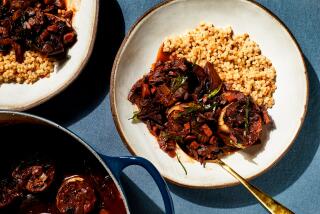An Eggplant by Any Other Color
A few little-known facts about the eggplant:
* It belongs to the same botanical family as tomatoes and potatoes.
* The varieties of this vegetable range from the size of a cherry to a cantaloupe and may be egg-shaped or elongated, as well as round.
* All varieties have edible skin, but it varies in thickness and tenderness. The exterior color can be lavender, deep purple, green, orange, white or even striped, but the cream-colored interiors are similar, so it’s possible to use most types interchangeably in recipes.
* The subtle-flavored flesh makes a good foil for spicy sauces, and its meaty texture adds creamy bulkiness to recipes containing little or no animal fat.
The most common type found in American markets is large, pear-shaped or globular, with deep-purple skin and a green cap. These Western eggplants typically weigh about a pound each, and their flesh tends to be more bitter than that of other varieties.
Japanese eggplant also has a deep-purple exterior, but it is long and slender. The skin is thinner, the flesh smoother, with fewer, smaller seeds.
The Chinese variety is similar to the Japanese, although slightly longer and lavender in color. The flesh tends to be sweeter and more tender than darker-skinned varieties.
There are several varieties of white eggplant. The Thai, also called turtle egg, is small and round; the Chinese and Casper, elongated; white-egg and Easter-egg varieties are medium in size and shaped as their name implies. Flesh of white varieties tends to be firmer, creamier and less bitter. The skin of some is tough and thick, requiring peeling.
Tiny, round, green eggplants from Thailand grow in clusters. Their crisp texture makes them ideal for pickling, but they also add bitterness and crunch to some Asian recipes. They cannot be used interchangeably with other varieties. There are also larger green-skinned varieties, both round and egg-shaped.
Another Thai variety resembles a miniature pumpkin, bright-red-orange rather than gold-orange in color. It is used mainly in that country’s sweet-sour dishes and should not be substituted for other varieties.
Most varieties of eggplant are available year round. Whatever type selected, choose those firm and heavy for their size. The skin should be glossy and taut, the flesh firm--without soft spots.
Purchase about 1/3 pound per serving. For recipes, one pound of eggplant is equal to three cups of the diced vegetable.
Eggplant, which is very perishable, should be used as soon as possible after purchase. It may, however, be stored in the refrigerator in a plastic food bag two to three days.
To prepare eggplant for cooking, rinse with cold water and pat dry with paper towels. Cut off and discard the stem. When you have cut the flesh, rub the cut surface with lemon juice to keep it from discoloring.
Sprinkling the raw flesh of the globe eggplant with salt decreases the amount of oil it absorbs during frying, reduces the moisture (and bitterness) and helps prevent it from becoming too watery in recipes. (This procedure may be eliminated with other varieties.)
Cut a globe eggplant crosswise into 1/2-inch slices with a chef’s knife (Step 1). Sprinkle each slice liberally with salt (Step 2), then place in a colander (Step 3) and drain 30 minutes. Rinse each slice with cold water and pat dry with paper towels (Step 4).
Eggplant may be peeled, but the tender skin of most varieties adds color, flavor and texture. Further preparation depends on the original size, shape and cooking method.
To Bake: Cut eggplant into 1/2-inch slices. Brush all sides with oil, then arrange in single layer in shallow baking pan. Bake at 450 degrees 20 to 30 minutes, until browned and tender when pierced.
To Boil or Steam: Cut eggplant into cubes. Cook in small amount of boiling water 4 to 5 minutes or until tender, or steam over simmering water 4 to 5 minutes.
To Grill: Use miniature or small varieties. Cut tiny eggplants in half, larger ones in thick wedges. Grill over low coals until streaked with brown and tender when pierced, 12 to 15 minutes.
To Fry: Cut eggplant into 1/2-inch slices. Heat oil in large skillet over medium-high heat. Cook eggplant in single layer, without crowding, 8 to 10 minutes or until browned on both sides and tender when pierced. It’s important to keep the temperature of the oil hot enough to prevent the eggplant from absorbing too much, but not so hot the slices brown before they are tender.
Overcooking eggplant only makes it creamier. Aluminum pans will discolor this vegetable, however, so it’s best to cook eggplant in stainless steel, glass or enamel.
Take advantage of the different sizes and shapes of eggplant--small ones for single servings, firm-textured varieties when a recipe calls for slices that will be rolled, medium to large for stuffing. Cooked eggplant may simply be topped with garlic butter and herbs or sliced tomatoes and shredded cheese, then heated under the broiler.
More to Read
Eat your way across L.A.
Get our weekly Tasting Notes newsletter for reviews, news and more.
You may occasionally receive promotional content from the Los Angeles Times.









